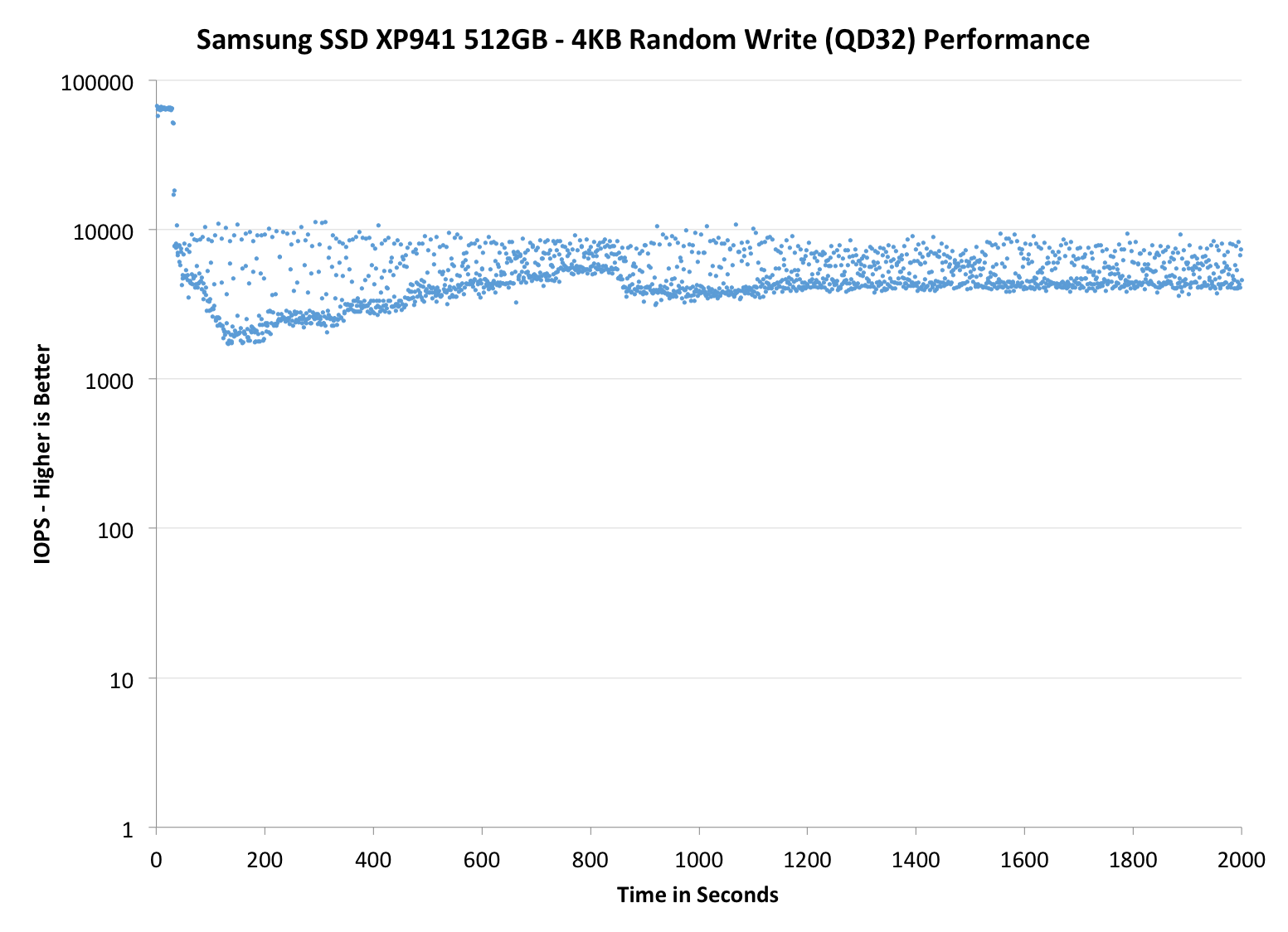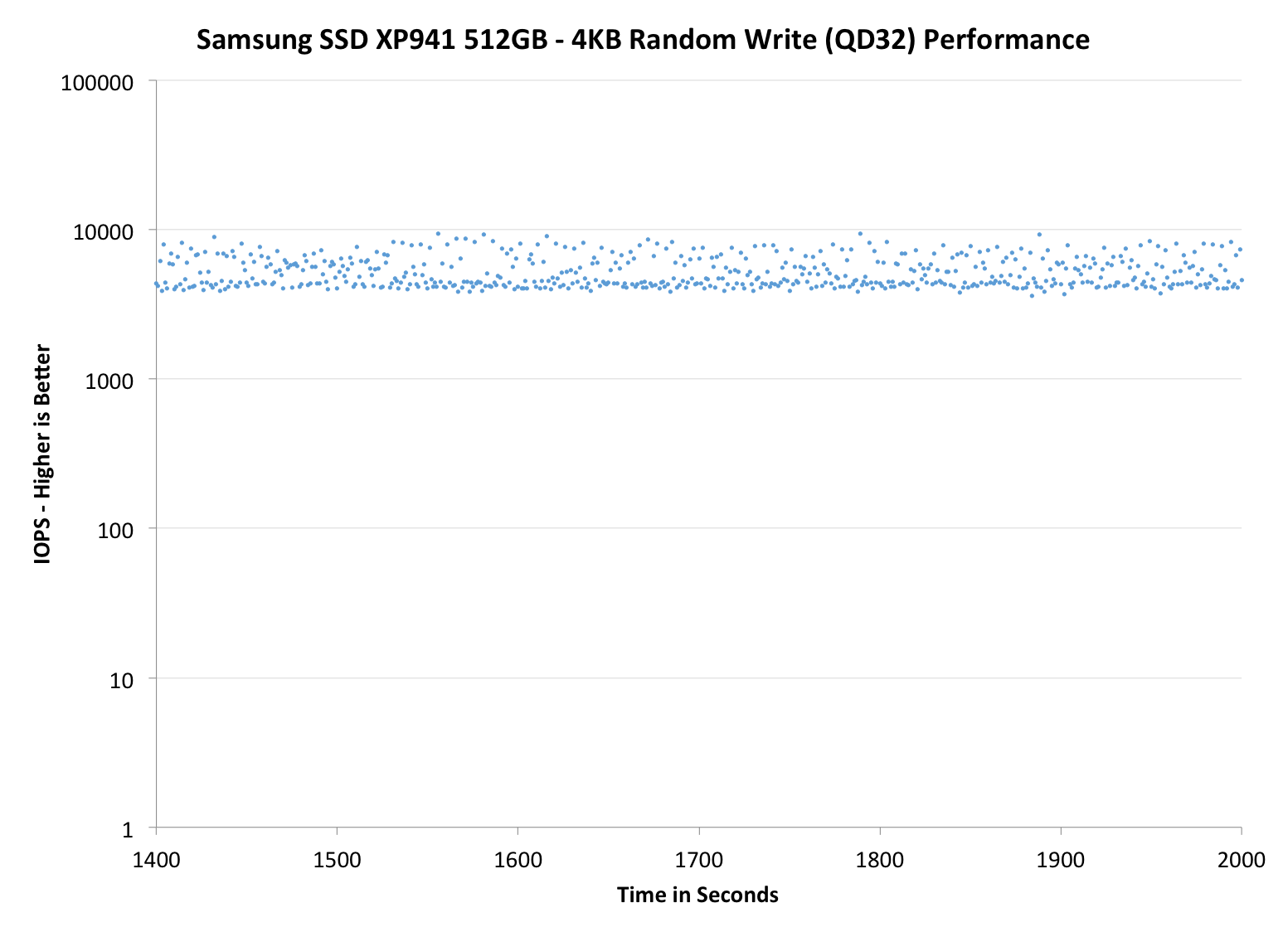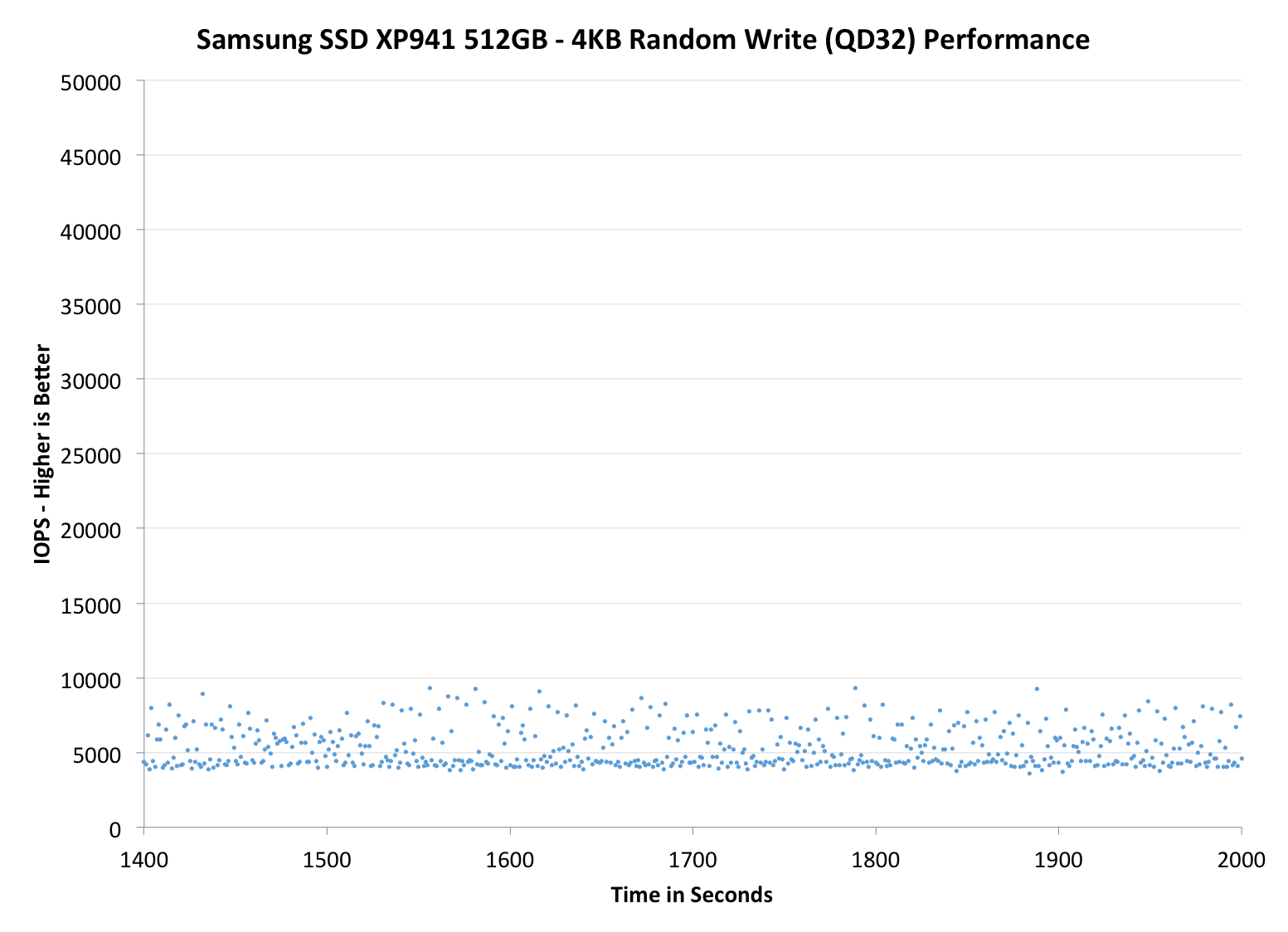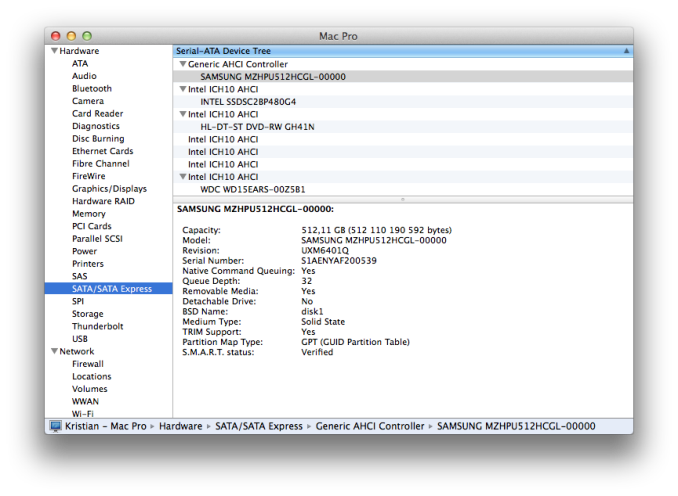Samsung SSD XP941 Review: The PCIe Era Is Here
by Kristian Vättö on May 15, 2014 12:00 PM ESTPerformance Consistency
Performance consistency tells us a lot about the architecture of these SSDs and how they handle internal defragmentation. The reason we don’t have consistent IO latency with SSD is because inevitably all controllers have to do some amount of defragmentation or garbage collection in order to continue operating at high speeds. When and how an SSD decides to run its defrag or cleanup routines directly impacts the user experience as inconsistent performance results in application slowdowns.
To test IO consistency, we fill a secure erased SSD with sequential data to ensure that all user accessible LBAs have data associated with them. Next we kick off a 4KB random write workload across all LBAs at a queue depth of 32 using incompressible data. The test is run for just over half an hour and we record instantaneous IOPS every second.
We are also testing drives with added over-provisioning by limiting the LBA range. This gives us a look into the drive’s behavior with varying levels of empty space, which is frankly a more realistic approach for client workloads.
Each of the three graphs has its own purpose. The first one is of the whole duration of the test in log scale. The second and third one zoom into the beginning of steady-state operation (t=1400s) but on different scales: the second one uses log scale for easy comparison whereas the third one uses linear scale for better visualization of differences between drives. Click the buttons below each graph to switch the source data.
For more detailed description of the test and why performance consistency matters, read our original Intel SSD DC S3700 article.
 |
|||||||||
| Samsung SSD XP941 | Plextor M6e | Samsung SSD 840 Pro | SanDisk Extreme II | Samsung SSD 840 EVO mSATA | |||||
| Default | |||||||||
| 25% Spare Area | |||||||||
The interface has never been the bottleneck when it comes to random write performance, especially in steady-state. Ultimately the NAND performance is the bottleneck, so without faster NAND we aren't going to see any major increases in steady-state performance.
The graphs above and below illustrate this as the XP941 isn't really any faster than the SATA 6Gbps based 840 Pro. Samsung has made some tweaks to their garbage collection algorithms and overall the IO consistency gets a nice bump over the 840 Pro but still, this is something we've already seen with SATA 6Gbps SSDs. I wouldn't say the IO consistency is outstanding because the Plextor M6e does slightly better with the default over-provisioning (both drives have ~7%) but if you increase the over-provisioning the XP941 will show its magic.
 |
|||||||||
| Samsung SSD XP941 | Plextor M6e | Samsung SSD 840 Pro | SanDisk Extreme II | Samsung SSD 840 EVO mSATA | |||||
| Default | |||||||||
| 25% Spare Area | |||||||||
 |
|||||||||
| Samsung SSD XP941 | Plextor M6e | Samsung SSD 840 Pro | SanDisk Extreme II | Samsung SSD 840 EVO mSATA | |||||
| Default | |||||||||
| 25% Spare Area | |||||||||
TRIM Validation
Update 5/20: I got an email from one of our readers suggesting that the TRIM issue might be related to Windows 7 and that Windows 8 should have functioning TRIM for PCIe SSDs. To try this, I installed Windows 8.1 to a secondary drive and ran our regular pre-conditioning (fill with sequential data and torture with 4KB random write for 60 minutes). To measure performance, I had to rely on Iometer as HD Tach didn't work properly under Windows 8. I ran the same 128KB sequential write test that we usually run (QD=1, 100% LBA) but extended the length to 10 minutes to ensure that the results are steady and not affected by burst performance.
| Samsung SSD XP941 512GB - Iometer 128KB Sequential Write (QD1) | ||
| Clean | After TRIM | |
| Samsung SSD XP941 512GB | 607.7 MB/s | 598.9 MB/s |
And TRIM seems to function as it should, so it indeed looks like this is just a Windows 7 limitation, which is excellent news.
------------------------
To test TRIM, I took a secure erased XP941 and filled it with sequential data, followed by a 60-minute torture with 4KB random writes (QD32). After the torture, I TRIM'ed all user-accessible LBAs and ran HD Tach to produce the graph below:
It looks like TRIM isn't functional, although I'm not that surprised. I'm waiting to hear back from Samsung about whether this is a limitation in the operating system because I've heard that Windows doesn't treat PCIe drives the same even if they utilize the same AHCI software stack like the XP941 does. If that's true, we'll need either updates to Windows or some other solution.
In a Mac TRIM support is listed as "yes" when TRIM is enabled for third party drives using TRIM Enabler, though I didn't have the time to verify if it actually works.












110 Comments
View All Comments
RamCity - Monday, May 19, 2014 - link
The Lycom M.2 to PCie adapter does a reasonable job with small form factor computers. It has a low-height bracket in addition to the standard height one. Note though, you can't boot the XP941 in any windows PC with one of these adapters as far as we know - it wont show up in the bios as a bootable device. Only in a 2006-2012 Mac Pro under OSX will it be bootable.Rod
Oscarcharliezulu - Monday, May 19, 2014 - link
Nice job anandtech... You detected what country i was reading this from and inserted appropriate text/prices? Great job. Appreciated.kizh - Tuesday, May 20, 2014 - link
still running my sandy 2500k that did 4.8 reliably until I updated bios. I bought a z67 board that had a pcie 3.0 x 16 lane as an early adopter. The only thing worth upgrading on it was the graphics so bought a 780 (on accident thought it was a 780 ti) I spent about 24 hours of my time researching making it work on a early version of uefi and trying multiple set ups. Gonna send it back, its not worth upgrading my whole system for this.Never buying another feature that isn't being used yet, by the time its truly a standard your warranty is over and FU if it got tweaked a little.
Got 2 M2 in raid, no trim ever bothered me. Its fast enough, don't need this. Maybe if a whole system upgrade was as fun as it used to be,
Right now all I see waiting for is a 4k display port standard and some nicer models coming out. I want to throw money at these guys but not for next to nothing,
I'm not rich by any measure but dumped money on tech as a hobbyist.
kizh - Tuesday, May 20, 2014 - link
oh just to clarify I know it would only be pcie 3.0 with ivy, I didn't expect that chip to be such a let down. Still this should have worked at pcie 2.0. Also when I say m2 I'm talking about the model name of my ssd's. not m.2just some clarifications
sfgebrqy - Wednesday, May 21, 2014 - link
I would have bought this in a heart-beat if it weren't for two things:1) Average/bad 4k random read/write
2) Abysmal 4k scaling with QD
The killer feature for this SSD is without a doubt its sequential performance. Compared to any single SSD alone, it blows it out of the water on the benches, whether
practical or synthetic.
The caveat is "single SSD". RAID 0 can always be used to boost sequentials. Maybe not exactly linearly, but close to linearly. Take a look at the review for 2 Samsung 840
Pros in RAID 0 (page 3). I can't link (or even mention the website) it because the comment filter says its spam, so take a guess and use Google. Sequentials are nearly
doubled for both read and write.
The kicker is that this CANNOT be done for random I/O at low QD. Which is to say, if we wanted better random I/O from XP941s, we couldn't RAID them together to do it. In
fact, RAID typically makes random I/O marginally worse at low QD due to overhead. See the aforementioned review (page 4).
RAID does multiply random I/O at high QD, but with XP941 4k QD scaling non-existent to begin with, it's a lost cause.
Even if we did want to RAID XP941s together, I can't seem to find any tests/reviews of more than two at once, let alone a RAID controller capable of putting more than two
M.2 devices in RAID 0. Meanwhile, there are plenty of RAID controllers capable of pushing 16+ SATA3 devices (albeit bottlenecked at x8 PCIe 3.0).
The bottom line is that if I found out that my current SATA3 SSD RAID 0 array wasn't putting out enough sequential, I could just add a few more SSDs to solve the issue. If I
found out that my XP941 array wasn't putting out enough random I/O, there's nothing I could do to fix it.
If you're in the market for single SSDs and your system can handle M.2, then this is the cream of the crop. If you have RAID arrays though, wait until M.2 becomes more
popular and Samsung pushes a new M.2 SSD with better random I/O performance.
skrewler2 - Sunday, May 25, 2014 - link
Sorry late to the party but this part of the article is just ignorant:"Using an SSD as a secondary drive can make sense for e.g. a video professional where the performance can be utilized as a scratch disk, but otherwise the only real use case for an SSD is as a boot drive"
What the hell?
aviv - Wednesday, June 4, 2014 - link
Hey gr8 reviewI got question about the graphs
Its log systemic
Does it means when its lower by 1/10 its just half of the value or
In between its linar
brentpresley - Thursday, July 3, 2014 - link
ASUS just released a new BIOS today (7/3/2014) that allows for M.2 boot support of the XP941.I just installed it and the BIOS can see the XP941 in AHCI mode now.
iBurley - Wednesday, December 3, 2014 - link
If put into the M.2 slot of one of the ASRock Z97 boards mentioned in the review, will this be running at full speed, or would I need an adapter like you tested with to use the full potential of the drive?On ASRock's website, under the port listing for the board, it states "1 M.2 (PCIe Gen2 x2 & SATA, Supports 30mm, 42mm, 60mm, 80mm, 110mm M.2 devices)" but I don't know if that just means the interface or if it would actually go over the PCIe bus instead of SATA.
SERGE 2015 - Tuesday, July 14, 2015 - link
I have AsRock's Z97 Extreme6 and XP941 and it is unfortunately NOT bootable out of the box. As it's been mentioned - once the system boots up using another EFI source, the XP941 becomes visible and can then load whatever been installed on it. This is due to lack of OpROM on XP941. The new Samsung SM951 been declared as "Supports Standard AHCI driver" though.